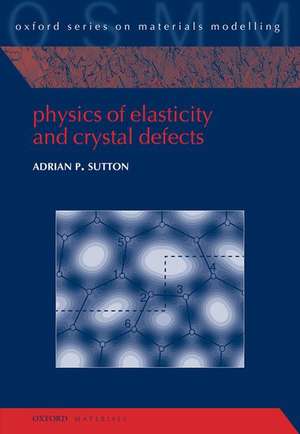Physics of Elasticity and Crystal Defects: Oxford Series on Materials Modelling, cartea 6
Autor Adrian P. Suttonen Limba Engleză Hardback – 25 iun 2020
| Toate formatele și edițiile | Preț | Express |
|---|---|---|
| Hardback (2) | 375.12 lei 10-16 zile | |
| OUP OXFORD – 25 iun 2020 | 375.12 lei 10-16 zile | |
| OUP OXFORD – 21 mar 2024 | 417.72 lei 10-16 zile | +90.65 lei 6-10 zile |
Preț: 375.12 lei
Preț vechi: 427.43 lei
-12% Nou
Puncte Express: 563
Preț estimativ în valută:
71.79€ • 77.95$ • 60.30£
71.79€ • 77.95$ • 60.30£
Carte disponibilă
Livrare economică 22-28 martie
Preluare comenzi: 021 569.72.76
Specificații
ISBN-13: 9780198860785
ISBN-10: 0198860781
Pagini: 288
Ilustrații: 38 color line figures
Dimensiuni: 179 x 249 x 19 mm
Greutate: 0.73 kg
Ediția:1
Editura: OUP OXFORD
Colecția OUP Oxford
Seria Oxford Series on Materials Modelling
Locul publicării:Oxford, United Kingdom
ISBN-10: 0198860781
Pagini: 288
Ilustrații: 38 color line figures
Dimensiuni: 179 x 249 x 19 mm
Greutate: 0.73 kg
Ediția:1
Editura: OUP OXFORD
Colecția OUP Oxford
Seria Oxford Series on Materials Modelling
Locul publicării:Oxford, United Kingdom
Recenzii
Adrian Sutton's Physics of elasticity and crystal defects is a concise, modern and refreshing introduction to a topic that is key to all of materials science and engineering. It is a great textbook to teach from as well as for those who want to learn the material on their own.
Sutton is a giant in the field... I am certain this book will be a classic.
Superb... and written in an excellent, engaging style Sutton is an internationally respected expert in structural materials science and condensed matter physics, one of very few people to have such status in these two domains simultaneously.
Sutton emphasizes the physical meaning behind the mathematical models he clearly introduces. The style is simple, didactic, and effective. The coverage of some of the Open Questions in Chapter 10 (e.g. electroplasticity) is entirely unique to this book.
Although there are other relevant texts in this field, this book includes connections to atomic treatments of defects. These are timely additions, and provide new physical insights. Although the book contains much mathematics, it is essentially readable, and stimulating.
This is an outstanding book. Students will appreciate the clarity of the arguments, including careful derivations of some important formulas for elasticity.
The book is highly accessible, and provides the level of insight into the subject that you would rarely find in academic literature It is particularly significant that the author has made a clear connection between Physics and Elasticity and Defects in this book. There is an established element of tradition here, where L. D. Landau and E. M. Lifshitz included Theory of Elasticity in their famous Course in Theoretical Physics. This new book by Adrian Sutton matches the Landau-Lifshitz book extremely well, providing new, modern insights into the phenomena, and matching the needs of contemporary generations of students and researchers.
It is quite obvious that the majority of the content is material that the author has worked through from scratch, much of it original, and this is especially reflected in the problems, which are detailed and novel.
Sutton is a giant in the field... I am certain this book will be a classic.
Superb... and written in an excellent, engaging style Sutton is an internationally respected expert in structural materials science and condensed matter physics, one of very few people to have such status in these two domains simultaneously.
Sutton emphasizes the physical meaning behind the mathematical models he clearly introduces. The style is simple, didactic, and effective. The coverage of some of the Open Questions in Chapter 10 (e.g. electroplasticity) is entirely unique to this book.
Although there are other relevant texts in this field, this book includes connections to atomic treatments of defects. These are timely additions, and provide new physical insights. Although the book contains much mathematics, it is essentially readable, and stimulating.
This is an outstanding book. Students will appreciate the clarity of the arguments, including careful derivations of some important formulas for elasticity.
The book is highly accessible, and provides the level of insight into the subject that you would rarely find in academic literature It is particularly significant that the author has made a clear connection between Physics and Elasticity and Defects in this book. There is an established element of tradition here, where L. D. Landau and E. M. Lifshitz included Theory of Elasticity in their famous Course in Theoretical Physics. This new book by Adrian Sutton matches the Landau-Lifshitz book extremely well, providing new, modern insights into the phenomena, and matching the needs of contemporary generations of students and researchers.
It is quite obvious that the majority of the content is material that the author has worked through from scratch, much of it original, and this is especially reflected in the problems, which are detailed and novel.
Notă biografică
Educated in materials science at the Universities of Oxford and Pennsylvania, Adrian P. Sutton has worked for more than 40 years on theory and simulation of defects in crystalline materials. He has published more than 230 papers on electronic, atomistic and continuum level modelling of defects. In 2005 he was appointed to a Chair in the Department of Physics at Imperial College London. In 2009 he established and led the renowned Centre for Doctoral Training (CDT) on Theory and Simulation of Materials at Imperial College. This book is based in part on a course he gave in the CDT for 10 years. He was elected to the Royal Society in 2003.







